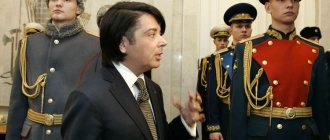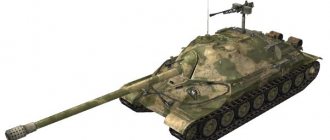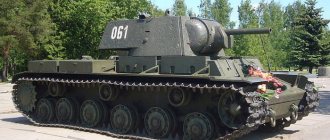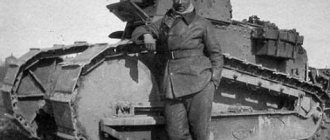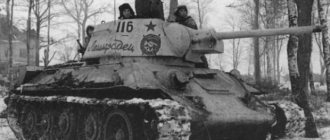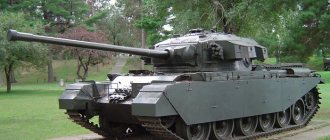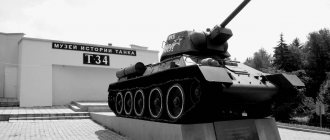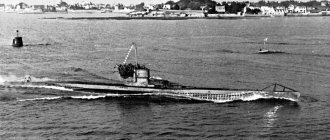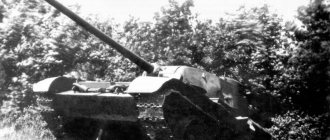The hero of this article, the T-54 tank has recognizable features, a classic layout and is considered one of the best mass-produced USSR tanks of all time. The enormous success of this model can be easily explained. Traditionally, the combat vehicle turned out to be simple, convenient, balanced and reliable. The most important thing is that the developers were able to take into account all the errors based on the invaluable experience of the Second World War.
Serial production of the T-54 was organized until 1959, and then the tank was replaced by the T-55 and T-62.
History of creation
The design work of the T-54 (or as it appeared at the beginning - “Object 137”) was carried out at the Uralvagonzavod design bureau in Nizhny Tagil under the leadership of A.A. Morozov. The basis was the T-44 model, which was designed and tested in 1943-44.
The main task set before the developers was to create a model capable of replacing the mass-produced wartime vehicles - T-34 76 and T-34 85. It was also necessary to provide protection against 75 and 88mm shells, which replaced previous calibers in tank building.
The T-44 prototype already had enough armor to withstand 75mm shells.
At first, the front of the hull was made of steel sheets 75 mm thick. Later it was made 25 mm thicker, which further increased survivability. An obvious drawback of the T-44, which did not allow the vehicle to become a serial product, was the artillery system. It remained the same as on the T-34 (85mm).
The project for the future T-54 began to be developed in 1944, and already in January 1945, tests began in Kubinka near Moscow. The beginning of serial production is considered to be April 1946.
Tank for peacetime
Despite the new index, this tank was, in fact, a modernized T-44, since the chassis, hull and many transmission elements were inherited from it unchanged or almost unchanged. However, in terms of armament and level of protection, it was a completely different machine! Exactly how different was to be understood during testing at the Kubinka training ground, where the newcomer arrived on March 10, 1945.
The testing of the experimental tank was completed only in mid-April, and the results were not the best. In many respects, the T-54 was inferior to the T-34-85 and T-44, which, however, did not surprise anyone, because we were talking only about the first prototype. But it surpassed both them and other medium tanks of that time in terms of armament and protection. This became perhaps the main argument in favor of the testers’ conclusion, which stated: the tank can be recommended for adoption by the Red Army. Before this, of course, having eliminated all the many shortcomings and shortcomings that were discovered at the test site, and they were a list of 68 points!
The second prototype was assembled and submitted for testing after the Victory - by July 1945. Compared to the first T-54 prototype, it featured many innovations, primarily in the transmission, as well as a new turret with the LB-1 cannon. The result of the second tests, which lasted until November, turned out to be the same as the first: it was recommended for adoption after eliminating all discovered deficiencies, the list of which was no less than the previous time.
This shouldn't be surprising. On the one hand, testing new models of such a complex machine as a tank is always accompanied by many comments. On the other hand, you need to understand that in the second half of 1945, tanks were no longer required only to have the power of weapons and thickness of armor, but also to be easy to use, have normal working conditions and accommodate the crew. After all, now it was not a question of throwing an armored vehicle into battle, from which it might not return, but of operating it for several years, and even using it to train conscript soldiers.
Development and design features
The development of the T-54 took place at the Uralvagonzavod design bureau in 1943-1944. The goal of the development is to improve the best WWII tank, the T-34. The work on creating a new tank was headed by general designer A.A. Morozov. A few years earlier he had successfully developed the T-34 itself. The general layout of the armored hull and the slope of the frontal part were left almost unchanged. The general similarity between the T-54 and the T-34 is clearly visible externally. The shape of the tower has been changed. It has become more rounded with a reduced profile in height, but the main change is the rearrangement of the engine and transmission. Instead of a longitudinal engine placement, a transverse one was used, which significantly freed up space for ammunition and crew.
Engineers have done a lot of work in selecting rational angles of inclination. The meeting of the projectile with the armor will almost never be directly at an angle of 90. This is clearly visible in the appearance of the T-54 and is what gives it such an unusual appearance. Now these are quite common solutions that have migrated to the tank industry of all countries of the world, but then it was an innovative solution. The final version was presented in March-April 1945. Colonel E.A. Kulchinsky (head of the state commission) made an interesting opinion:
The new tank was impressive. The shape of the armor took into account the angles of contact with enemy shells, and this gave the hull a streamlined and beautiful appearance. This unusual beauty of form told specialists about the high technical parameters of the combat vehicle. Fine-track tracks with 10 road wheels indicated the ability to move at high speeds. The long barrel of the gun is designed for high initial projectile speed.
Between development in 1944 and serial production in the 50s, the T 54 tank would undergo more than 650 different modifications recommended by the state commission. The lantern gearing of the tracks will appear, and the design of the tower will change. With each new modification, the noticed shortcomings were eliminated. T-54 is the main medium tank for mass production. Its design was approached very carefully, with hundreds of hours of testing.
Reservation and other protection
The development of the T-54 was aimed at making the armor completely invulnerable to 76 and 88 mm projectiles. There were no cumulative shells back then, and these requirements were quite realistic. In complete analogy with the legendary T-34, the most powerful frontal armor was made. The creation of the T-54 was preceded by the T-44. Frontal armor was increased by 30% and reached 90 mm. Side armor - 75 mm. On the T-54 they went even further. The frontal plate and part of the turret are 150-180 mm. Onboard - 90-150 mm. The final version of the T-54 already had a turret with 200 mm armor. These indicators are at the modern level for a medium tank weighing 35 tons, despite the fact that the product was designed 70 years ago.
The T-54 tank uses steel armor. The sides are rolled. The turret and front of the hull are cast. Also, for the first time, armor plates on top of tracks began to be widely used on a medium tank. With them, tanks acquired a modern look. The driver's gap has been removed from the front armor shield. For the T-34 it was a very vulnerable point. When a shell hit the armor, the impact through the gap caused a blinding and deafening effect. The T-54 was reviewed through optical surveillance devices. Their use made it possible to improve visibility around the tank, which is especially important for fighting in urban environments.
The weight of the tank does not allow using too much armor. During the design, a mandatory condition was set - maintaining high maneuverability and mobility, so as not to repeat the mistakes of super-heavy tanks. In the 40s, there were no high-speed electronic guidance systems (even ATGMs were aimed manually via wire), so the high-speed tank was perfectly protected. Strengthening armor while maintaining low weight and without using more powerful engines (which cannot be designed quickly) is possible only by reducing the armored volume. The interior space is compressed with significantly redesigned ergonomics. The lightweight T 54 tank weighed 36 tons, despite the fact that the thickness of the turret armor reached 200 mm.
Tactical and technical characteristics (TTX) of the T-54
- Weight, t – 36
- Crew, h – 4. Commander, Gunner, Loader, Driver.
- Case length, mm – 6002
- Case width, mm – 3270
- Height, mm – 2218
Booking
| Body forehead (top), mm/deg. | 120 / 60° |
| Body forehead (bottom), mm/deg. | 100 / 55° |
| Hull side, mm/deg. | 80 / 0° |
| Hull feed, mm/deg. | 45 / 17° |
| Bottom, mm | 20 |
| Turret front, mm/deg. | 200 / 0°106 / 60° |
| Tower side, mm/deg. | 160 / 0°85 / 60° |
| Tower feed, mm/deg. | 65 / 0°56 / 30° |
| Tower roof, mm | 30 |
Chassis
The tank received an independent torsion bar suspension for the rollers, which reduced weight, reduced dimensions (the height of the tank decreased by 30 cm) and improved driving performance. The undercarriage of each side consisted of 5 support cast metal rollers with rubber-coated rims and hydraulic shock absorbers on the first and last rollers. The driving wheels are rear, the caterpillar engagement is lantern. With suspended equipment installed around the tracks, the tank could swim up to 60 km with waves up to 5 points.
- Engine power, l. With. – 520
- Maximum speed, km/h – 50
- Cruising range on the highway, km – 300
- Specific power, l. s./t – 14.4
- Climbability, degrees. – 30°
Armament
The main armament of the T-54 was the 100-mm D-10T cannon. The length of the gun barrel is 56 calibers. This gun was developed in the design bureau of artillery plant No. 9 under the leadership of F. F. Petrov for the SU-100. The armor-piercing projectile of its 100 mm cannon was capable of penetrating a vertical armor plate 125 mm thick at a distance of 2000 m. After World War II, its improved versions were in service for forty years after the development of the original modification. Additional armament consists of a 7.62 mm machine gun coaxial with the cannon, located to the right of the cannon. The tank continued to be produced even after the T-62 was adopted.
Engine and its characteristics
A significant increase in armor mass required a new powerful engine. Moreover, while the production of new housings can be mastered relatively quickly, this cannot be done with the engine due to the large number of parts. The most popular tank engine of that time was the B-2 diesel engine from the T-34, so the T-54 was equipped with its modification, the B-54. This engine already provided almost ideal efficiency capabilities. Suffice it to say that the efficiency was already almost at the level of 250 g/kW, which corresponds to the most modern standards. The developer and manufacturer of the B-54 is the Chelyabinsk Tractor Plant.
B-54 is a low-speed 12-cylinder diesel engine. Power - 520-550 hp. The low speed of the motor significantly increases its reliability (structural loads are reduced), but requires a large working volume. The B-54 has a volume of 38.8 liters. The liter power indicator is 14.5 hp/l. For example, in a high-speed diesel car, this figure reaches 70 hp/liter, which is five times higher. Despite the huge volume of the engine, its weight was small, about 960 kg. The diesel engine operates on a classic four-stroke circuit with high efficiency. The operating speed range of the engine is small - 2000-2400 rpm. This has only a positive effect on efficiency.
The V-54 engine is also available in a civilian version. The V-55 engine can be purchased and used to drive diesel power plants, trucks, excavators, and universal chassis. These motors are quite widely used in the oil and gas industry: drilling rigs, all-terrain vehicles, pumps.
When to use the employee account form
Form T-54a is unified (approved by Decree of the State Statistics Committee of the Russian Federation dated January 5, 2004 No. 1) and is used by an accountant to enter information about monthly accruals and deductions made for a specific employee throughout the year.
Such personal accounts are created for each employed employee. Information to be entered into form T-54a is taken from primary documents relating to the employee, as well as other documentation that takes into account actual output (work performed, amount of working time worked).
The basis for opening a personal account for an employee is an order to hire him. At enterprises with a large staff, T-54a forms are filled out personally for each employee, but if there are not so many employees, an alternative is possible - maintaining special statements.
You will learn more about one of these statements from the material .
Modifications
- T-54 model 1949 – new turret. Hull armor has been reduced to 100 mm.
- T-54 model 1951 is again a new form of turret. New sights installed.
- T-54K - “Commander”. Additional radio and navigation equipment. Adopted into service in 1954.
- T-54A – Upgraded D-10TG gun with vertical stabilizer. New sights. Night vision device for driver. Adopted into service in 1955.
- T-54AK – “Commander” T-54A. Add. radio station and navigation equipment. Adopted into service in 1958.
- T-54AM - New engine, 580 hp. Ammunition increased to 43 rounds. Rollers from the T-55 tank. New underwater driving and communication system. Rangefinder. There are also a lot of changes that are particularly minor.
- T-54B – New D-10T2S gun with stabilizer. Infrared night vision sight for the gunner. Night vision device installed in the commander's tower. Rotating floor of the fighting compartment. The fuel supply has increased to 1212 liters, which makes it possible to cover 430 km without refueling. Entered service on September 11, 1956.
- T-54BK - “Commander” T-54B. Add. radio station and navigation equipment.
- T-54M (“Object 139”) – Developed in 1954. New gun D-54TS. Changed add. weapons. New chassis, which will subsequently be used on the T-55. New sights and night vision devices. It was not accepted for service due to the complexity of production of the D-54TS cannon and its ammunition.
- T-54M (“Object 137M”) – Differs from “Object 139” by the D-10T cannon and the presence of a laser rangefinder. New caterpillars. Entered service on March 18, 1977. All T-54s were upgraded to its level.
- T-54MK – “Commander” T-54. Add. radio station and navigation equipment.
- Tyrant 4 – Israeli modification. New engine with 610 hp power. 60 mm mortars are installed on the right side of the turret.
- Type 62 – Chinese light tank. Weaker armor and an 85 mm Type 62-85TS cannon were installed. Adopted into service in 1963.
- Type 59 – Chinese medium tank. There should have been a completely identical T-54A. However, in China it was equipped with anything. Adopted into service in 1958.
- Type 69 – Chinese main battle tank. Adopted into service in 1982.
- Type 79 – Chinese main battle tank. Adopted into service in 1984.
- Type 80 – Chinese main battle tank. Adopted into service in 1988.
Yuri Pasholok. The first of the T-54 family
Home » Real story » Little-known and unrealized projects of tanks and other armored vehicles » Yuri Pasholok. The first of the T-54 family
Little-known and unrealized projects of tanks and other armored vehicles
byakin 04/30/2021 1416
19
in Favoritesin Favoritesfrom Favorites 8
Yuri Pasholok. The first of the T-54 family
A story about the T-54 medium tank model 1946, on display at the Museum of Russian Military History
The question of a replacement for the T-34 medium tank was first raised at the end of 1940. At first there was talk of a relatively minor modernization, but by the spring of 1941 the T-34M was formed, which had a lot of differences from the original vehicle. This includes a three-man turret, a torsion bar suspension, and a gradual increase in armor protection. It was assumed that in the second half of 1941 the T-34M would replace the T-34 in mass production, but the outbreak of the Great Patriotic War crossed out these plans. However, work continued. In 1942, a new T-34M project appeared, with a two-man turret and enhanced armor protection, but it remained a design project. This option served as the basis for a new tank - the T-43. Unlike its predecessors, this tank was built in two versions. The T-43 was very unlucky, because by the time it was theoretically ready to go into production, it required increased armor protection and armament. And if the armament was strengthened without any problems, then strengthening the frontal part of the hull to 90 mm was fraught with an increase in combat weight to 35 tons. Further development of the T-43 turned out to be a pointless exercise.
T-54 model 1954 in the Museum of Russian Military History
In the fall of 1943, KB-520 of plant No. 183, headed by A.A. Morozov began work on the tank, designated T-44. Unlike the T-43 and its predecessors, which were an evolutionary development, this was a revolutionary project. By placing the engine across the hull, it was possible to move the fighting compartment back. As a result, the frontal part of the body finally lost the driver's hatch. The T-44 did not turn out right away, the car went through several stages of evolution, but the concept itself turned out to be correct. Due to a more dense layout and a fundamentally new chassis, the combat weight of the T-44 was 30 tons with a significant increase in armor protection. On November 3, 1944, Stalin signed GKO Resolution No. 6997ss “On the adoption of T-44 tanks and ensuring their production with B-44 diesel engines.” After 3 years, the successor to the T-44 finally took on its final shape, or so it seemed at that time. Meanwhile, KB-520 of Plant No. 183 was working on a modernization of the T-44, known as the T-44B. The main difference between the tank was its armament in the form of a 100-mm D-10T gun. After reviewing the project at the GBTU KA and NKTP (People's Commissariat of Tank Industry), order No. 637c was signed on November 1, 1944. In it, the T-44B was designated as the T-54 for the first time. In practice, the T-54 turned out to be a different tank in many ways. They installed a reinforced chassis on it, developed a turret from scratch, and strengthened its armor protection. The first prototype of the T-54 was manufactured by February 14, 1945, then factory and field tests began. Like the T-44, the new tank faced a difficult fate, and at first the appearance of the vehicle changed quite significantly.
This tank was released in October 1947, the 19th vehicle in the series
On April 29, 1946, Resolution No. 960-402ss of the Council of Ministers of the USSR was signed, according to which the T-54 was adopted by the Soviet Army. They accepted it largely in advance, since work on the car was still ongoing, and plans for production were very different from reality. Initially, it was assumed that in May 1946, plant No. 183 would deliver the first two tanks, and by December the production volume would be 80 vehicles. In total, 188 tanks of this type were expected to be delivered in 1946. In practice, everything turned out to be completely different. No production T-54s were ever delivered in 1946. In fact, the production of these machines began only in the summer of 1947. Plant No. 183, with a plan of 250 tanks, delivered 22 vehicles, including reference copies, while factories No. 75 and No. 174 did not deliver a single T-54. And the tank itself, known as the T-54 model 1946, turned out to be a vehicle with a difficult fate. In 1949, this tank was discontinued, and the last vehicles were accepted as training ones. It also went down in history as perhaps the most expensive Soviet medium tank. The cost of the T-54 produced in 1947 was an exorbitant 1,372,289 rubles (for comparison, the T-44 produced in 1947 had a cost of 272,700 rubles).
The restoration work lasted for more than a year, then for several more months the tank was refined in small details.
The topic of the T-54 model 1946 is worthy of a separate article, but today we will talk about something else. Two such tanks have survived to this day in more or less their original form. The first of them (serial number 707B1, produced in July 1947, the seventh production vehicle) is located on the territory of museum site No. 2 of the Patriot Park (former tank museum in Kubinka). This is the only T-54 model 1946 that has been preserved in its original configuration. In our case, we will talk about another car. This tank was released in October 1947, it is the 19th production model. The tank went through several stages of modernization, but during the restoration it was returned to its original appearance. Now this tank is on display at the Museum of Russian Military History. The big Friday article is dedicated to him.
This is how the tank was before restoration. Instead of a box with a machine gun there was a tool box
It must be said that the T-54 model 1946 turned out to be a rather rare vehicle. In 1948, its large-scale serial production finally began. Thus, for reasons of secrecy, this tank was designated; in 1948, 285 units were delivered. In Kharkov, at plant No. 75, 218 tanks were delivered, another 90 vehicles were delivered at plant No. 174, Omsk. This was, to put it mildly, far from the release plans, but the main problem was something else. After the vehicles went into service with the troops, mass complaints began. It turned out that the chassis was rather weak, the idea of machine guns in boxes on the fenders was unsuccessful, and the tank itself was overloaded. And there were a number of questions about the tower. Therefore, on February 18, 1949, a command was issued to suspend production of the T-54. By that time, Plant No. 183 had already delivered 13 tanks of this type. In total, in 1949, the factories delivered 96 of these tanks, which were called “training” tanks.
The same tank after the first, main stage of restoration. It was brought into line with its appearance at the time of release
At plant No. 183, work urgently began on modernizing the T-54, as a result of which the T-54 model 1949 appeared. As for the T-54 model 1946, a massive program to modernize these vehicles began in 1951. The fenders were expanded, the front-facing machine guns were removed from them, and new tracks with a width of 580 mm were installed. This was only the first wave of modernization; then there was a second wave, during which the cars changed even more. They went to training units, although there are photographs of such tanks in the Egyptian army. As a result, a situation equivalent to T-44 occurred. Nowadays there are completely original T-44 and T-54 model 1946 based on the same model. And if pictures of the T-44 in the troops before modernization are not very rare (and they fought in Budapest even before modernization), then the T-54 model 1946 was not lucky. If there are photographs of these tanks in the army before alterations, these are isolated cases. The bulk of these vehicles were photographed after modernization.
The rest of the finishing work was already underway in the museum workshop.
The hero of this material had exactly the same fate. In 1948, the tank ended up in service with the troops, had exactly the same problems with operation, then it was modernized, then a second, then a third... Then the tank became a tactical object, after which it found a new life. The car was brought into an external condition that best matches its original appearance. The author of this material was directly involved in these works. Partially restored to the original appearance and interior of the car. Naturally, there is room for improvement in terms of restoration, but the main stage of work has been completed. Next comes finishing work, which lasts for years. This is the specificity of the restoration of military equipment. If anyone thinks anything is easy to get these days, I have bad news. Nobody thinks that between 1946 and the early 60s, 3 generations of headlights changed - FG-12, FG-100/FG-102 and FG-125/FG-127. The same thing happened with the side lights. A carload of such little things and a small cart.
Before modernization, the tank had 500 mm wide tracks, which turned out to be too narrow
One of the characteristic features of the first production T-54 was a track with a width of 500 mm and a pitch of 137 mm. Unlike the previous T-44, it had nothing to do with the T-34 track, since back in 1945 there was a requirement to transfer the drive wheel from the ridge wheel to a more reliable lantern gear. The truck is, in general, not bad, but with one small problem. It looked good on the 30-ton T-44, but not on a tank whose combat weight exceeded 36 tons. The specific ground pressure turned out to be too high, and the tracks were deformed. Therefore, these same tracks were replaced with a new design, 580 mm wide. As for the 500 mm wide track, it came in handy. Later he appeared on the T-44M and the AT-T tractor.
The second feature of the T-54 model 1946 is the machine guns in the outer boxes. The military had been eating Morozov's baldness about them for more than one year. The result was sad and funny
The second characteristic feature of the T-54 model 1946 was the SG-43 machine guns, installed in special boxes on the outside of the tank. With these same boxes, the spacecraft's gas turbine unit was destroying Morozov's brain from the very beginning of the tank's design. And if the first samples did not have SG-43, then they still had to be installed, because the customer could not eat, but wanted to supply them. But here there is a funny situation: the fact is that on the T-54 model 1946, produced in 1948 by plant No. 75, Kharkov, there is a hole for a machine gun. Such is the mystery. Not to mention the fact that cars from different factories and production have different body designs. This is especially true for the shape of the welded joints on the front of the hull.
As you can see, the boxes are not symmetrical. Spurs for track tracks are attached to the front wings
The creators of the installation of course machine guns had no less fun in the process of creating drives to control these same machine guns. In the top view you can clearly see that there are some tubes coming from the boxes. These are nothing more than casings for the cables of the machine gun cocking system. Pull the cable and the machine gun will cock. No less fun is the fact that the machine guns are positioned asymmetrically. The reason is that the driver's hatch flap runs into the box on the left. For this reason, the left box had to be moved back. But the “joy” was revealed in 1948. It turned out that the box was blown away when driving through a wooded area. As a result, the boxes began to be removed during the first wave of T-54 modernization.
Installation of checkers BDSh-5
Initially, the tanks were equipped with naval MDS smoke bombs; they were planned to be introduced on Soviet tanks and self-propelled guns back in 1941. Since they did not have time to master the issue, they became a mass phenomenon only in 1944. MDSh were also installed on the T-54 model 1946. In the early 50s, large smoke bombs BDSh-5 appeared, practically the same thing. However, even the BDSh-5 is rarely seen in museums these days. However, such checkers can be seen in the Museum of Russian Military History.
Driver's hatch in stowed position
One of the main advantages of the T-44 and T-54 over the T-34 was the solution to the issue of placing the driver's hatch. Actually, initially the T-34 wanted to make it on top, but it didn’t work out. On the T-44 they left a rudiment in the form of a viewing slit, but on the T-54 this was also removed. But now in the stowed position the driver had an excellent view. The driver's seat was height adjustable, which made it possible to drive while leaning out of the hatch. The hatch itself was fixed at the same time so that it would not work like a guillotine.
Placement of periscope observation devices for the driver
Despite the fact that the general layout of the control compartment of the T-54 was descended from the T-44, there was a significant difference between these tanks. This was especially true for viewing devices. The idea with a periscopic device in the hatch, which was implemented in the T-44, was abandoned on its descendant, since it turned out to be not entirely successful. Instead, two non-rotating periscopic devices were installed, one of them with a slight rotation to the right. It feels like quite a decent overview, especially when compared with the viewing devices of the T-34 driver.
The driver's position compared to the illustration from the operating instructions
The general concept of the driver's seat on the T-54 has become, one might say, canonical for some tank-building schools. It must be said that several countries independently came up with a similar idea; something similar can be seen in Centurion. And the German Leopard 1 produced something similar. This is not plagiarism, but just a statement of fact - some solutions to problems have very similar solutions. Moreover, later Soviet and British tank building came up with the idea of placing the driver in the center of the hull, while the Germans left him on the right side.
The T-54 turret model 1946 was descended from the IS-4
Another characteristic feature of the T-54 model 1946 was the turret. When developing the turret of the first two T-54 samples, the IS-6 was indicated as a reference point. After control tests of IS-6 turrets at UZTM showed their low resistance when fired from the flanks, the reference point was changed. Now the IS-3 heavy tank was indicated as a model. But it also turned out to be not the most successful example, since it did not have a feeding niche and in general did not turn out to be quite a suitable standard. As a result, the closest analogue was the IS-4, which, by the way, was adopted by the Soviet Army on the same day as the T-54. This particular tank had a rear niche, characteristic traps around the perimeter, and a wide gun mount with large movable armor. The 100-mm D-10T tank gun, as well as the SG-43 coaxial machine gun, easily fit into such a turret.
As subsequent events showed, the idea of copying the concept of the IS-4 turret, which was indicated from above, turned out to be unsuccessful
Of course, there was no talk of completely copying the IS-4 turret. For example, the obsession with a large single hatch, which had two doors, was ignored by plant No. 183. The IS-3 and IS-4 had poor visibility, unlike the T-54. At the same time, the general placement of the elements, as well as the shape of the tower, is quite guessable. And here the wishes of KB-520 to follow the example of Chelyabinsk designers backfired. A similar tower with zamans was originally made for Object 260. The shelling of the turret of Object 260 showed that the zamans have a number of serious shortcomings. Therefore, the final tower of Object 260 was domed. Later they came to her for the T-54, but not right away. However, in 1949, when the list of improvements to the T-54 was compiled, a turret without forward mounts was a top priority.
The idea with massive armor for the gun mantlet was also not particularly successful.
Another unfortunate legacy of the IS-4 was the gun mount. On the one hand, the resulting design seems to be convenient. But on the other hand, she turned out to be vulnerable. The fact is that often hitting the movable armor led to it jamming. Both the KV and later the British on the Centurion got their fill of this. Therefore, the list of corrections to the T-54 design in 1949 included a modification to the gun mount. By the way, a similar evolution can be seen on Centurion. The FV4201, FV4202 and Centurion Action X (like the American T95 medium tank) had very narrow gun mount armor for a reason. The reasons are the same as the solution to the problem.
A large aft niche was needed to accommodate ammunition in the first stage stowage
It must be said that they were extremely reluctant to part with the bait in the stern. The fact is that the first stage of installation was located in the niche, but they did not want to give it up. Therefore, even when the turret was being modernized, the minimum ammo was left, and it contained several cartridges for the D-10T. The T-54 fits a little more - 7 rounds in the niche. The stowage in the niche, by the way, is very convenient; it is clearly better than the “shelves” on the T-34-85 and T-44. This is especially true in light of the greatly increased weight and dimensions of the unitary cartridge. The total mass of the unit for the D-10T is 30 kg, and the length is more than 110 cm. So the issue of convenience is not an idle one.
An awning and cables for self-pulling logs were attached to the aft part of the tower
The stern of the T-54 model 1946 was not empty at all. Ever since the days of the T-34-85, the stern of the tower has been the location of the awning. It was attached to special belts, which, in turn, were attached to hooks welded on the tower. But that's not all. There were also cables attached to the back, the functionality of which is not known to everyone. On the T-54, the self-pulling log was already a standard element of the tool, but in order to attach it to the tracks, this cable was needed.
The DShKM anti-aircraft machine gun and its turret were borrowed from the IS-3/IS-4
Another element that became standard on the T-54 model 1946 was the anti-aircraft turret. She was of Chelyabinsk origin. This turret was originally created for the ISU-122s, then it appeared on the IS-2 and ISU-152, and later the turret was modernized for installation on the IS-3 and IS-4. From them, this design, in a slightly modified form, migrated to the T-54. And it cannot be said that the original idea turned out to be successful.
Ring turret in stowed position
The essence of the modernization was that the turret was initially attached to a swivel on the commander's cupola. The IS-3 and IS-4 did not have commander's cupolas, so a special ring appeared. In the stowed position, the ring was located behind the hatch. In the combat position, the ring was removed from the stopper, it described an arc, locked in the combat position, and the loader now had the opportunity to conduct all-round fire. So, with minimal changes, this design went to the T-54, despite the fact that it had a full-fledged loader hatch.
She's in a fighting position. The idea turned out to be not the best, so the turret was then changed
At plant No. 183 the turret design was slightly modified. In particular, a certain analogue of the backrest appeared, which slightly improved the working conditions of the loader. However, the idea turned out to be not the most successful. Most importantly, there was no deep meaning in this particular design of the ring “nozzle”. Therefore, later the turret moved directly to the loader’s hatch, which was able to rotate around its axis. Why this was not done immediately is a mystery.
The design of the commander's cupola turned out to be quite successful
The commander's cupola of the T-54 model 1946 turned out to be its own, original, and very successful. At first, factory No. 183 tried to make a lowered version of the T-44 turret, but it didn’t turn out very well. As a result, a serial turret was born, with three viewing devices - PTK-1 in the center and two periscopes on the sides. Subsequently, the turret was modified by changing the composition of the secondary viewing devices.
She's from the inside
The main observation device in the commander's cupola was the PTK-1, which was a development of the MK-IV periscope device. He first appeared on the T-44. For ease of use, the front part of the turret had special handles with which it was possible to rotate the upper part of the turret around its axis. A convenient design, which was further developed in subsequent versions of the tank.
Tank commander's position
Let's move on to the fighting compartment. Currently, some elements inside the tower are the result of a compromise. Initially, the tank was equipped with a 10-RT radio station and intercoms of the TPU-4BIS-F-26 type. They can just be seen in the black and white application. Currently, the tank is equipped with communications equipment that appeared later. Naturally, work is being done to bring it to maximum authenticity, but 10-RT itself is rare, and there is no need to talk about TPU. In general, as soon as possible.
Location of the first stage laying
The stowage of the first stage is located in the aft niche (7 cartridges), plus another cartridge is mounted on the right side of the turret. The system is quite convenient, and also designed to minimally rotate the large and very heavy ammunition inside the fighting compartment. So far the stacks are empty, but the museum is working in this direction.
Basic packing for 20 rounds. Mounts for 3 more cartridges are visible on the right
On the right side of the driver is the main stowage for 20 rounds. It may seem that such placement of ammunition is not entirely reasonable, but in fact the solution is common. A similar system for placing ammunition was used on a significant part of the tanks of the post-war period. Also, additional cartridges were placed on the sides of the fighting compartment. You can also see the floor panels of the fighting compartment. They made the work much easier, at the same time covering the torsion shafts.
To the right of the gun is the loader's position
The loader's position in the T-54 model 1946 turned out to be more convenient than on the T-44 and especially the T-34-85. It must be said that due to the increase in the diameter of the shoulder strap to 1816 mm, the tank was more spacious than its predecessors. You can also note a full-fledged seat for the loader, on the T-44 and especially the T-34-85, this is somewhat simpler.
Commander and gunner seats
Continuing the theme of seats. We worked at plant No. 183 and on the positions of the commander, as well as the gunner (gun commander). The tank commander's seat could recline upward. This is convenient, but you have to be careful, otherwise you can get hit on the top of your head with this very seat. The gunner's seat also reclines, but not up, but down. This creates a passage to the control compartment.
Gunner's workplace
From the point of view of the general construction of the gunner's position, the T-54 was a logical development of ideas that had been going on since the T-34. Quite a typical set of guidance mechanisms and observation devices. In addition to the turret rotation mechanism, there was also an electric motor, which had a variable rotation speed, which was very convenient. The articulating TSh-20 was used as a sight, a further development of the “breakable” sights that appeared in 1943. Due to the hinged design, the sight was placed more conveniently than a conventional “telescope”. Instead of a periscope sight, a MK-IV viewing device was installed. In a word, a typical gentleman's set, which was quite enough for work.
Installation of a coaxial machine gun. On the right side there is a mount for a box with a belt for a coaxial machine gun
Separately, it is worth mentioning the coaxial machine gun. If the T-44 and its predecessors were equipped with machine guns of the DT family, then the T-54 was equipped with the SG-43. A significant difference between the Goryunov machine gun was its belt feeding, which meant there was no need to constantly change magazines. The tape was placed in a box to the right of the machine gun.
Finally, it is worth saying that even a number of shortcomings that were discovered on the T-54 did not make it a tank without a future. The car partly repeated the fate of the Centurion, which at first also had a number of shortcomings. Meanwhile, it later became one of the most popular post-war tanks, which remained in service for more than half a century. The T-54, as well as its descendants, are still fighting. Well, what happened at the beginning of his career is a common occurrence. Machines that last a long time are often born in pain.
List of sources:
- RGAE
- Author's archive
source: https://zen.yandex.ru/media/yuripasholok/pervyi-iz-semeistva-t54-6085a8427b54072a7607c74d
Vehicles based on T-54
- OT-54 – Flamethrower tank. It was equipped with an ATO-1 flamethrower. Externally, it was no different from the T-54. Entered service on May 14, 1954.
- “Object 483” – Flamethrower tank. Instead of a gun, an OM-250 flamethrower and a 9K116 “Kastet” anti-tank complex are installed. Not accepted for service due to lack of a cannon.
- “Object 530” – Self-propelled anti-aircraft gun. Equipped with two 57-mm Oka-1 anti-aircraft guns. Not accepted for service due to the start of work on more advanced 30-mm and 37-mm anti-aircraft guns.
- “Object 560” – Special. car. There was no turret with weapons. Instead, a cruise missile launch complex was installed. Firing range - from 10 to 120 km. It was not accepted for service due to the start of work on a more advanced P2P project.
- BMR-2 – Armored mine clearing vehicle. Adopted into service in the 1980s.
- BTL-1 - Armored Bat. Installed on the BP-1 armored train. Entered service on March 1, 1971.
- BTS-2 – Tractor. Entered service in February 1955.
- BTS-4A – Tractor. Adopted into service after 1955.
- BREM-3 – Repair and recovery vehicle. Adopted into service in 1980.
- GPM-1 – Tracked fire engine. Entered service in 1986.
- ZSU-57-2 – Self-propelled anti-aircraft gun. Equipped with two 57 mm anti-aircraft guns. Entered service in 1955.
- MTU - Bridge Layer. Adopted into service in 1982.
- SPK-12G – Self-propelled slewing crane. Entered service on September 21, 1967.
- SU-122-54 – Self-propelled artillery unit. Gun - 122 mm D-49.
- T-54-T – Tractor. Developed in the GDR. Adopted into service in 1965.
- Akhzarit - infantry fighting vehicle. Developed in Israel. Entered service in 1987.
Modifications and modern models
T-54 is the record holder for the number of modifications. More than 100 modifications are known, and design work in this direction continues in many countries:
- MBR-2 - armored mine clearing vehicle;
- Object-350 - self-propelled anti-aircraft gun with a 54-mm automatic cannon;
- AT-T - tractor with a car cabin on the T-54 chassis;
- BTS-2 - armored tractor for artillery;
- GMF - tracked fire engine for extinguishing fires in military warehouses;
- SPK-12 - crane for missiles;
- BREM-3 - armored, repair and recovery vehicle;
- OT-54 and TO-55 - flamethrower tanks 54;
- SU-122 - self-propelled guns based on the T 54.
There are also “modifications of modifications.” For example, radar machines, army cranes, trenchers, earth-moving machines and other equipment are made on the basis of the AT-T tractor. China is engaged in the most active modernization of T-54 tanks.
Combat use and military glory
The T-54 tank is the most popular not only in the Soviet army, but throughout the world. These vehicles appear every now and then in military footage of any armed conflict: Syria, Libya, Iraq, Yemen, Sudan. The USSR supplied tanks to all willing states. There were no serious restrictions on their supply. T-54s take part in almost every military conflict after the 50s.
The most widespread combat use of the T-54 tank was in the Afghan war. Despite the fact that the tanks were already outdated for the 80s, they performed well in battles, which was due to the limited volumes of anti-tank weapons from the enemy. The majority of the vehicles were lost to mines. Anti-tank missiles were not used in the Afghan war.
At the present time, the T-54 continues to participate in various armed conflicts. Work is underway to install modern weapons systems on the tank. For example, a standard 100 mm cannon allows you to fire guided projectiles.
Changing "four" to "five"
On April 29, 1946, the T-54 was put into service, but full production began only two years later. This time was spent on implementing the “Program for Eliminating Design Defects” of the new tank, and only in 1948 did the “fifty-fours” begin to enter service with the troops. We started... And almost immediately production was stopped again for almost a year in order to again begin to eliminate defects, shortcomings and shortcomings. During this time, the tank managed to receive, for example, a new turret, which was noticeably different from the old one. The previous one had a so-called “zaman”, that is, a reverse bevel, along the entire perimeter. During shelling tests, it became clear that this was one of the weakest points of the tank. On the new T-54 turret of the 1949 model, the “zaman” remained only at the rear, creating the impression of a rear niche.
The tank acquired its final and well-known appearance today only after another modernization, as a result of which the T-54 of the 1951 model was born. It already had a characteristic hemispherical turret without any “tricks”; new instruments and components appeared, additional attachments (for example, a new smoke screen system) and so on. This iteration of the '54 began production in 1952 and remained in production for two years. At the same time, the three tank factories that assembled the T-54 - in Nizhny Tagil, Kharkov and Omsk - produced up to two thousand vehicles annually.
The continuously improving T-54 tanks have become indispensable participants in testing domestic nuclear weapons. Then it turned out that they could provide their crews with good protection from weapons of mass destruction, but this required serious modification: sealing the tank and protecting the crew from the shock wave, as well as installing a forced ventilation system that would allow tank crews to work without chemical protective suits and gas masks. By that time, the modernized T-54B tank was already in production. It had a two-plane stabilized cannon, night vision devices and underwater driving equipment that allowed it to overcome water obstacles up to five meters deep and up to a kilometer wide. This modification became the basis for the creation of a new machine capable of fighting even in a nuclear war. After an anti-nuclear protection complex was installed on it and a number of other changes were made, prepared by the design bureau of the Nizhny Tagil plant, the result was actually a new tank.
According to one version, he received the T-55 index through the efforts of the director of Uralvagonzavod, who wanted to report on the release of a new tank. According to another version, the military insisted on this, seeking a documented difference between outwardly similar machines. One way or another, on May 8, 1958, the T-55 tank was adopted by the Soviet army. Its serial production began at all three factories that previously made the “fifty-four”, and in Omsk the last “fifty-fifth” were assembled in 1979! Today this vehicle is no longer in service with our army (removed in 2016), but about two and a half thousand T-55s remain in storage.
Trace in games
Perhaps the legendary T-54 tank received its greatest share of popularity with the release of the game World of Tanks. Among the key characteristics of the model are strong armor of the frontal part of the hull, excellent maneuverability, and good penetrating power of the gun.
Among the obvious shortcomings are the frankly weak side armor, low shooting accuracy and difficulty in aiming, and the vulnerability of the tanks and ammunition reserves in the fighting compartment. According to the presented characteristics, the game tank is close to the real state of affairs.
